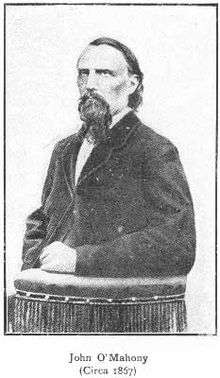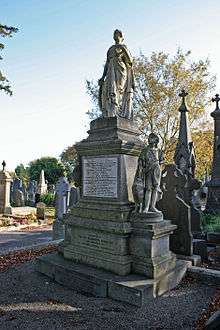John O'Mahony
John Francis O'Mahony (1815 – 7 February 1877) was a Gaelic scholar and the founding member of the Fenian Brotherhood in the United States, sister organisation to the Irish Republican Brotherhood.
John O'Mahony | |
|---|---|
 |
Early life
O'Mahony was born in 1815 in Kilbeheny, County Limerick or Cork or Tipperary, Ireland, into a family of minor Roman Catholic landed gentry. His father and uncle had been members of the United Irishmen and had taken part in the Irish Rebellion of 1798. He was educated at Midleton College by Dr Hamblin.[1]
On the death of an elder brother, O'Mahony inherited a property which yielded £300 per annum.[2] He entered Trinity College, Dublin, where he studied Sanskrit, Hebrew and Irish. He became an accomplished Gaelic scholar, and later taught Greek and Latin, and contributed articles to Irish and French journals. He left Trinity without getting a degree.[2][3]
Irish Politics
In 1843, he joined Daniel O'Connell's movement for the Repeal of the Union Act of 1800, but quickly became dissatisfied with the lack of progress and joined Young Irelander movement which Smith O'Brien led and took part in the failed Young Irelander Rebellion of 1848.[2][3]
Emigration
His participation in the rebellion obligated him to leave Ireland, and he settled for a time in Paris,[2] where he lived in great poverty.[4] In 1854, he joined John Mitchel in New York City, and took part in the Emigrant Aid Association, the Emmet Monument Association, and other Irish organisations.[2]
History of Ireland
In 1857, he published History of Ireland, by Geoffrey Keating, D. D., translated from the Original Gaelic, and Copiously Annotated (New York, 1857). Dr. Todd, in his preface to the Wars of the Gaedhill with the Gaell, says, "His translation of Keating is a great improvement upon the ignorant and dishonest one published by Mr. Dermod O'Connor more than a century ago, but has been taken from a very imperfect text, and has evidently been executed, as he himself confesses, in great haste." O'Mahony's notes are copied from O'Donovan's Four Masters, and it was on this ground that Hodges & Smith procured an injunction against the sale of the book in the United Kingdom.[2] The mental strain to which O'Mahony was subjected in the preparation of this work, which brought him no pecuniary gain, affected his reason, and he was removed by his friends for a short time to a lunatic asylum.[3]
Fenian Brotherhood
In 1858, O'Mahony organised the Fenian Brotherhood in the U.S.A., closely associated with the Irish Republican Brotherhood in Ireland.[5][6] The object of the association was to secure the separation of Ireland. The name was probably derived from O'Mahony's Gaelic studies, the Fenians having been a military body in pagan Ireland, celebrated in the songs of Ossian.[3] The early portion of Keating's History is occupied with the exploits of the ancient Fenians.[2] The organisation of the new society was completed at conventions that were held in Chicago in 1864, and in Cincinnati in January 1865.[3]
Civil War
At the time of the Cincinnati convention, O'Mahony held the rank of colonel of the 69th Regiment of New York State Militia, recruited mainly from the ranks of the Brotherhood, which had also furnished a large proportion of Meagher's Irish Brigade, the Corcoran Legion, and Irish regiments engaged in the US Civil War.[2] The rapid growth in membership of the Fenian Brotherhood rendered it impossible for O'Mahony to retain the colonelcy of the 69th regiment, which he had held for some time, and resigning he gave all his attention to the spread of Fenianism.[3]
Fenian growth
The close of the civil war in the spring of 1865 gave a great impetus to the Fenians, owing to the number of Irish-American soldiers that were disbanded and anxious to see service elsewhere. Money poured into the Fenian exchequer; probably $500,000 was subscribed between 1860 and 1867.[3] Many differences occurred between O'Mahony and James Stephens and the Central Council relative to the policy to be pursued for the attainment of their object,[2] but O'Mahony remained president of the organisation for several years. He did not take any part personally in the attempted insurrection in Ireland or in the raids on Canada, although his advice counted for much in these enterprises.[3]
Later years

He devoted the last years of his life to literary pursuits, but suffered from ill health, and he had a hard struggle to secure the bare means for subsistence. However visionary may have been his objectives, he was honest, and although thousands had passed through his hands, he was often at a loss for a dollar. When his poverty was discovered, he declined to receive assistance in any shape.[3] He died in New York City in 1877 and soon after his death his remains were taken to Ireland and interred with the honors of a public funeral in Glasnevin Cemetery in Dublin.[2]
References
- R. V. Comerford, [https://doi.org/10.1093/ref:odnb/20751 "O'Mahony, John (1815–1877)" in Oxford Dictionary of National Biography (2004) online, accessed 22 April 2019, (subscription required)
- Alfred Webb (1878). "O'Mahoney, John". A Compendium of Irish Biography. Dublin: M. H. Gill & son. pp. 402–403.
- Wilson, J. G.; Fiske, J., eds. (1900). . Appletons' Cyclopædia of American Biography. New York: D. Appleton.
- . New International Encyclopedia. 1905.
- Gilman, Daniel Coit; Peck, Harry Thurston; Colby, Frank Moore, eds. (1905). The New International Encyclopaedia. New York: Dodd, Mead & Company. p. 940. Retrieved 29 August 2019.
- Ryan, Dr. Mark F. (1945). Fenian Memories. Dublin: M. H. Gill & Son Ltd. p. 92.